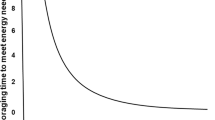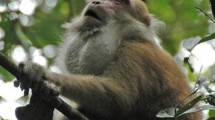Summary
Food consumption may reduce fighting intensity of territory owners by decreasing resource value (additional food cannot be consumed) and/or increasing fighting costs (food in the digestive tract may raise injury risks). A territorial harrier's (Circus cyaneus, adult females) decision to reduce its level of aggression should depend upon whether or not the intruder was a competitor for individual prey items (as are smaller male floaters) or for the territory proper (as are female floaters and especially female neighbors). Accordingly, following meals, aggressive intensity of owners was strongly reduced towards male floaters (more were ignored), slightly reduced towards female floaters (more were called at than chased), and remained unchanged towards neighbors (virtually all were chased). Hence, alterations in aggressive behavior of territory owners following food consumption may depend upon the type of intruder and the resource under contest (a food item or a territory).
Similar content being viewed by others
References
Altmann J (1974) Observational study of behaviour: sampling methods. Behaviour 79:272–312
Austad SN (1983) A game theoretical interpretation of male combat in the bowl and doily spider (Frontinella pyramitela). Anim Behav 31:59–73
Bildstein KL, Collopy MW (1985) Escorting flight and agonistic interactions in wintering northern harriers. Condor 87:398–401
Dixon WJ, Brown MB, Engelman L, Frane JW, Hill MA, Jennrich RI, Toporek JD (1983) BMDP statistical software. University California Press, Berkeley
Ewald PW, Carpenter FL (1978) Territorial responses to energy manipulations in the Anna hummingbird. Oecologia (Berlin) 31:277–292
Ewald PW, Orians GH (1983) Effects of resource depression on use of inexpensive and escalated behavior: experimental tests using Anna hummingbirds. Behav Ecol Sociobiol 12:95–101
Fienberg SE (1970) The analysis of multidimensional contingency tables. Ecology 51:419–433
Hixon MA (1982) Energy maximizers and time minimizers: theory and reality. Am Nat 119:596–599
Jenkins SH (1975) Food selection by beavers: a multidimensional contingency table analysis. Oecologia (Berlin) 21:157–173
Kodric-Brown A, Brown JH (1978) Influence of economics, interspecific competition, and sexual dimorphism on territoriality of migrant rufous hummingbirds. Ecology 59:285–296
Maynard Smith J, Parker GA (1976) The logic of asymmetric contests. Anim Behav 24:159–175
Parker GA (1974) Assessment strategy and the evolution of fighting behavior. J Theor Biol 47:223–243
Parker GA, Rubenstein DI (1981) Role assessment, reserve strategy, and acquisition of information in asymmetric animal conflicts. Anim Behav 29:221–240
Pennycuick C (1972) Animal flight. Edward Arnold, London
Riechert SE (1978) Games spiders play: behavioral variability in territorial disputes. Behav Ecol Sociobiol 3:135–162
Schoener TW (1983) Simple models of optimal feeding territory size: a reconciliation. Am Nat 121:608–629
Temeles EJ (1986) Reversed sexual size dimorphism: effect on resource defense and foraging behaviors of nonbreeding northern harriers. Auk 103:70–78
Temeles EJ (1987) The relative importance of prey availability and intruder pressure in feeding territory size regulation by harriers, Circus cyaneus. Oecologia (Berlin) 74:286–297
Temeles EJ (1989) Effect of prey consumption on foraging activity of northern harriers. Auk (in press)
Toft CA (1984a) Resource shifts in bee flies (Bombyliidae): interactions among species determine choice of resources. Oikos 43:104–112
Toft CA (1984b) Activity budgets of two species of bee flies (Lordotus: Bombyliidae, Diptera): a comparison of species and sexes. Behav Ecol Sociobiol 14:287–296
Ydenberg RC, Giraldeau LA, Falls JB (1988) Neighbors, strangers, and the asymmetric war of attrition. Anim Behav 36:343–347
Author information
Authors and Affiliations
Rights and permissions
About this article
Cite this article
Temeles, E.J. The effect of prey consumption on territorial defense by harriers: differential responses to neighbors versus floaters. Behav Ecol Sociobiol 24, 239–243 (1989). https://doi.org/10.1007/BF00295203
Received:
Accepted:
Issue Date:
DOI: https://doi.org/10.1007/BF00295203




